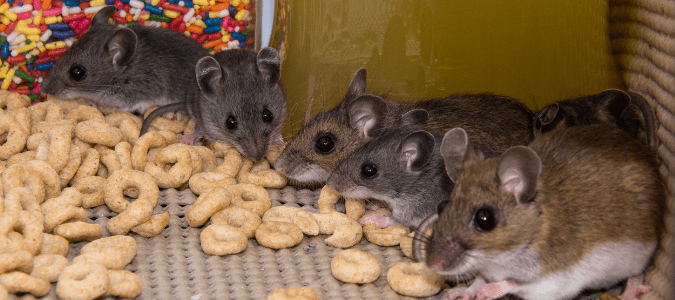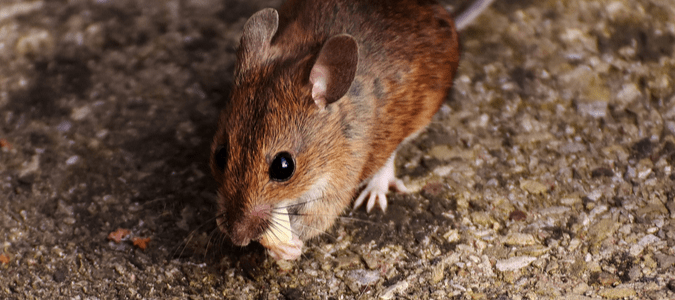Has a mouse made its home in your house? One furry little mouse may not seem like a huge problem; however, mice reproduce rapidly. A small colony can quickly turn into dozens of mice in your home in a matter of weeks.
Mice carry diseases, cause property damage and can invade your kitchen. To safeguard your home against a mouse infestation, it’s important to know about their life cycles and habits. Keep reading to learn how many mice live in a nest, what food attracts mice and how to keep mice away.
If you spot a mouse in your home or hear them at night, contact a rodent control specialist right away. Catching these unwelcome guests early is the best way to prevent them from taking over your home.
How Many Mice in a Nest?
Up to two dozen mice can live in a nest at a time. Mice have prolific breeding habits, which is how they can quickly overtake your home. Female mice only carry their babies for three weeks before giving birth, and they can get pregnant up to ten times a year.
Each mouse litter can have between five and twelve pups, and mice can start reproducing as young as three months old. The average lifecycle of indoor mice is around two years, which means that female mice can have more than one hundred babies in their lifetime.
Female mice can mate again as soon as they give birth, and they do not stop reproducing until they die. This rapid reproduction cycle is why mice are so difficult to control. Even one female mouse in your house can result in an overwhelming infestation.
If you suspect that there is a mouse colony in your home, contact a rodent control specialist right away. Mice are nocturnal, so you may not see one during the day, but you can hear them running through your walls at night.
Gnawing marks, a musky odor and mouse droppings are other common signs of an infestation. Make an appointment with a pest control specialist before the problem becomes a serious annoyance.
What Do Mice Nests Look Like?
Another common sign of indoor mice is spotting their loose nesting materials in your home. For example, they may steal some paper or fabrics to build their nests. Mice like using soft and fibrous materials to build their nests. Spotting loose materials where they don’t belong in your home is an indicator that mice are moving them throughout the night.
Other examples of nesting materials include:
- String
- Insulation
- Pillow stuffing
- Plant material
- Mattress batting
- Clothing pieces
- Food wrappers
- Newspaper
Unlike bird nests, mice nests are messy and not well organized. They either roll their collected materials into a tight ball or leave them in loose piles. Mice nests are typically between four to six inches in diameter. They are a nuisance for homeowners because they create a big mess that often contains food and mice droppings.
Mice build nests for a few reasons. First, it is a safe shelter to deliver and raise their pups. Mice pups are blind for the first few weeks of their lives, and the nest provides safety from predators.
Mice also use their nests to store food. Since they are nocturnal animals, they run back and forth between their nests and their food source during the night. When mice make their home in your house, their food source is often your kitchen. Mice tend to hoard food around their nests so that they have plenty to eat in a safe place away from predators.
Another reason that mice build nests is for warmth. They particularly like living in homes during the winter instead of living outdoors.
Where Do Mice Build Their Nests?
There are several locations in your home that are comfortable places for mice to nest. They like warmth, shelter and being close to their food source. For that reason, mice often nest in your kitchen.
They can hide behind appliances, in your lower kitchen cabinets and in your pantry. Mice particularly like appliances that have pilot lights because of the extra warmth they offer. However, they will also settle for electrical appliances to keep warm, which can become a problem if they start chewing through cords.
You may also find a mouse nest behind your hot water heater or inside your walls. Mice only need to create a small hole the size of a dime to get in and out of your walls. If you think you have a mouse infestation but don’t see a nest, inspect your walls for holes. Other signs of their presence include their high-pitched squeaks and an ammonia odor.
Another common place to find a mouse nest is in an empty drawer or a drawer that rarely gets used. They may even build nests in your garage if they can safely access food from there. Mice typically build their nests within 30 feet of their food source to limit their exposure to predators.
Mice may also live outdoors on your property, especially in the warmer months. You may find an outdoor mouse nest underneath shrubbery or in wooded areas around your home. They also like living under the exterior of manmade structures like homes and gazebos. Outdoor mice can still spread diseases and cause property damage, so you should contact a rodent control specialist if you see an outdoor mouse nest.
What Food Attracts Mice?
Living indoors gives mice endless food options. Mice prefer to eat grains, seeds, fruits and vegetables. However, they are omnivores and will eat meat and dairy too. They are not picky eaters and as scavengers, they will happily scrounge through your trash bins to find food.
Some of the most common foods that attract mice include:
- Plants
- Pet food
- Any type of leftovers
- Berries and juicy fruits
- Seeds and grains
- Meat
- Nuts
- Salty snacks like beef jerky
- Candy and chocolate
- Peanut butter
It is a myth that mice love cheese, but they will eat it if it’s an option for them. However, if any of the foods on the above list are available, they would prefer those over a block of cheese.
As you can see, homes are the perfect safe haven for mice because they have everything they need. They like living indoors because there are plenty of places to build their nests and it’s easy to access food and water.
Other than indoor pets and exterminators, they are also safer from predators inside. If you live in a cold climate, winter is especially a time when mice like to live inside to get out of the cold.
How to Keep Mice Away
There are several protective measures you can take to keep mice away. It starts with removing their access to food and water. Without an accessible food source, a mouse colony cannot make its home in an indoor building.
Do not leave food out in the open in your kitchen. That includes fruit bowls and dirty dishes in the sink. Keep a tight lid on your trash and compost bins so that mice can’t get inside them.
Keep your dried goods in airtight containers in your pantry rather than their original paper or plastic containers. If you have pets, only leave food out for them at meal times instead of leaving it out all the time. You should also store kibble in airtight containers since mice can chew holes through pet food bags.
Removing attractive options to build their nests is another way to keep mice away. They like living in cluttered areas such as near debris in your garage. Practicing cleanliness and proper sanitation can go a long way in deterring mice from making a house in your home.
Store loose papers, old clothes and linens in metal containers so that mice cannot use them to build their nests. You should also close up any small holes in your walls so that mice cannot enter through them.
The most effective way to keep mice away is to work with a rodent control specialist. They will inspect your home for potential entry points for unwelcome mice.
Keep Mice Out of Your Home for Good
Your home might be the perfect safe haven for mice, but they do not make good house guests. A couple of mice in your home can quickly turn into a frustrating problem since they reproduce so quickly.
Keep an eye out for mouse nests in your kitchen, garage and behind your walls. Do not give them easy access to nesting materials like paper and fabric. Keep mice out of your kitchen by storing your food properly and keeping the area sanitary.
Whether or not you’ve actually seen a mouse in your home, you should contact a pest control specialist as soon as you see signs of an infestation. Keep mice out of your home for good by catching the problem early and working with an expert.
ABC Can Control Your Mice Infestation
Dealing with a mouse infestation can be stressful and downright gross. Contact our pest professionals at ABC Home & Commercial Services. We can identify what type of mouse you’re dealing with and then implement an effective rodent control plan.



